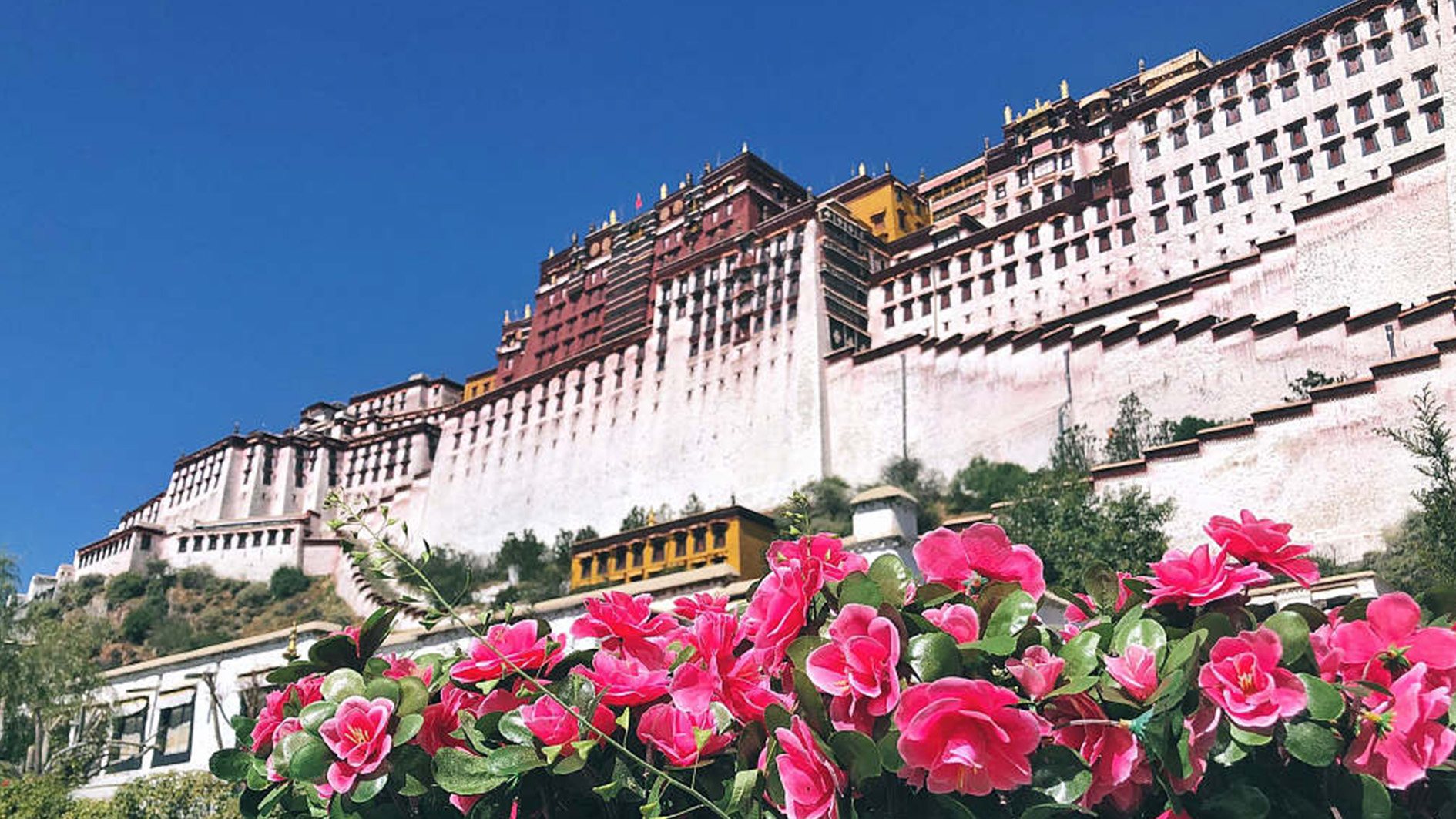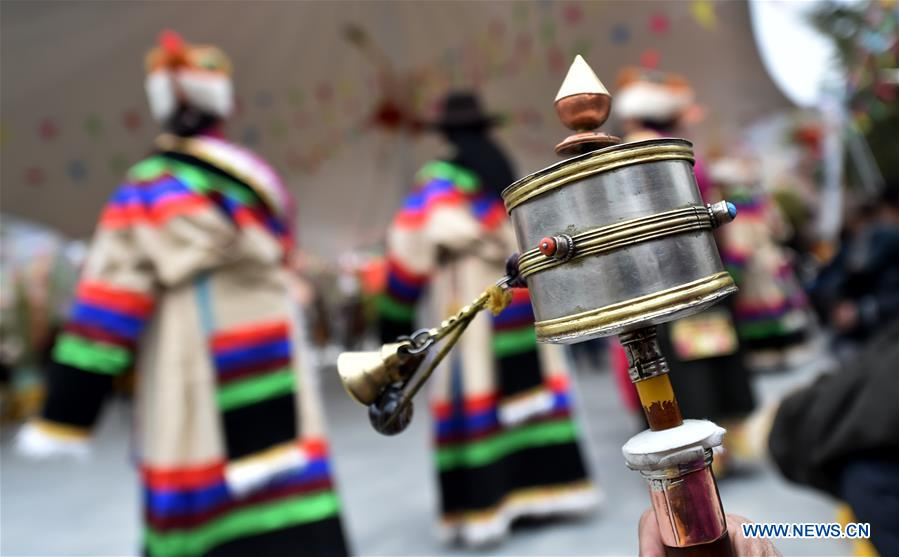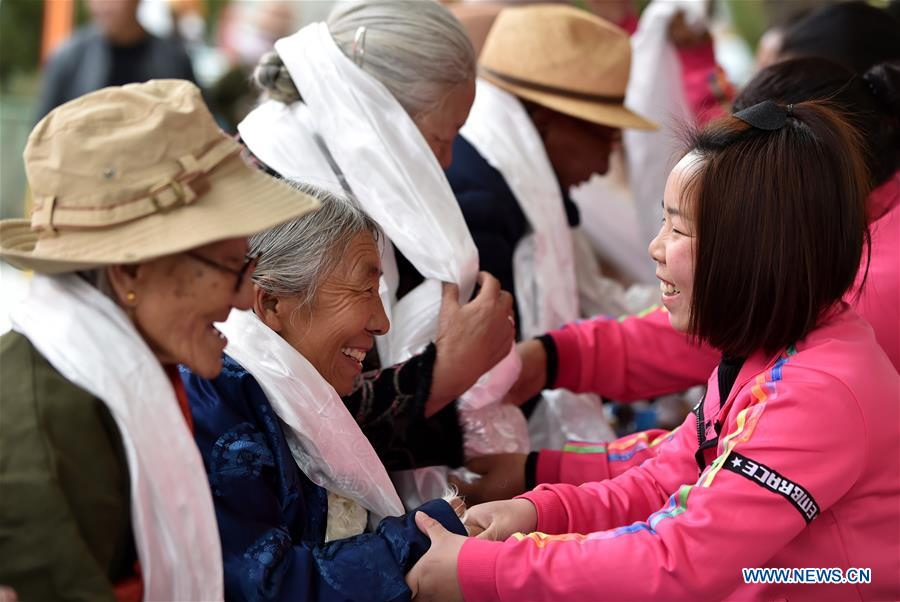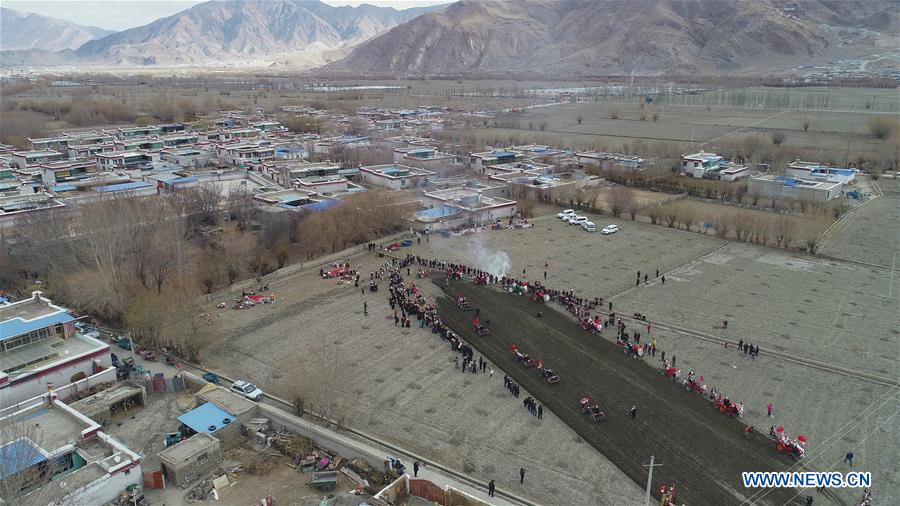02:31

China's State Council Information Office on Wednesday issued a white paper on the democratic reform and economic development in Tibet over the past six decades.
The democratic reform in Tibet is the greatest and most profound social transformation in the history of Tibet, the white paper titled "Democratic Reform in Tibet – Sixty Years On" said.
"By abolishing serfdom, a grim and backward feudal system, Tibet was able to establish a new social system that liberated the people and made them the masters of the nation and society, thus ensuring their rights in all matters," the paper said.
The cruel system of serfdom

People attend an event to celebrate the 60th anniversary of democratic reforms in Tibet, at a community in Lhasa, capital of southwest China's Tibet Autonomous Region, March 23, 2019. /Xinhua Photo
People attend an event to celebrate the 60th anniversary of democratic reforms in Tibet, at a community in Lhasa, capital of southwest China's Tibet Autonomous Region, March 23, 2019. /Xinhua Photo
The document noted in old Tibet, the three major estate-holders (governmental officials, nobles and upper-ranking lamas in monasteries) had a monopoly on almost all cultivated land, pastures, mountains, rivers and most livestock. The other one million Tibetan serfs and slaves had no personal possessions.
Thus, under the system, the three major deprived all rights of serfs, held in their hands the serfs' life and death, exploited them with exorbitant taxes and levies, and exercised strict mind control in the name of religion, it added.
The serfs were frequently subject to cruel tortures, such as gouging eyes, cutting off noses, and peeling off the skin.
"Serfdom is the most brutal form of slavery in feudal society. It is a barbaric and backward social system in terms of economic development, political democracy or human rights protection," the white paper read.
"By the 1950s, the very existence of feudal serfdom had violated the development trend of human history," said the white paper, noting that such a system was a stain on civilization and was destined to be eradicated by history.
Feudal serfdom abolished via democratic reform
The white paper pointed out the democratic reform pulled Tibetan serfs and slaves out of their misery.
The 17-point agreement, the shortened name of the Agreement between the Central People's Government and the Local Government of Tibet on Measures for the Peaceful Liberation of Tibet, was signed in Beijing on May 23, 1951.
After the agreement took effect, the People's Liberation Army marched into Tibet and entered Lhasa in October 1951.
The PLA and Communist Party of China (CPC) organizations in Tibet then worked hard to benefit the local people through measures including giving free medical treatment, building water conservancy projects, and providing disaster rescue and relief, the white paper said.
As a contrast, the 14th Dalai Lama and the reactionaries in Tibet's upper class still tried to maintain the system for fear that reform would deprive them of their political and religious privileges, together with their huge economic benefits. They tore up the 17-point agreement and launched a full-scale armed rebellion in March of 1959.
Under such circumstances, the central government decided to dissolve Tibetan local government, put an end to the rebellion and carry out democratic reform.
The white paper also added the contrast awakened the people in Tibet and some serfs stood up to oppose oppression and exploitation and some members of the upper class in Tibet also began to support democratic reform and see it in a more positive light.
After the democratic reform, 553 monasteries housing over 7,000 monks and nuns were retained in Tibet, which fulfilled the religious needs of local believers, it added.
Tibetan people are masters of their own lives

Young people present hada, a white ceremonial silk scarf, to the elderly in an event to celebrate the 60th anniversary of democratic reforms in Tibet, at a community in Lhasa, capital of southwest China's Tibet Autonomous Region, March 23, 2019. /Xinhua Photo
Young people present hada, a white ceremonial silk scarf, to the elderly in an event to celebrate the 60th anniversary of democratic reforms in Tibet, at a community in Lhasa, capital of southwest China's Tibet Autonomous Region, March 23, 2019. /Xinhua Photo
Tibet's democratic reform destroyed the institutional shackles which infringed serfs' rights to subsistence, marriage, migration, residence, work, personal freedom, human dignity, and education, according to the document.
Noting that people's governments were established at various levels for the people to exercise their rights after the reform, the white paper said that for the first time in the history of Tibet, local governments were elected in a democratic way through the exercise of the right to vote and to stand for election.
From September 1 to 9, 1965, the First Session of the First People's Congress of Tibet was held. At this session, Tibet Autonomous Region was established, and the People's Committee of the autonomous region came into being by election.
Since 1978, Tibet has held 11 elections of deputies to the people's congresses at township level, 10 at county level, and eight at the level of municipalities having subordinate districts, according to the document.
Currently, there are 35,963 deputies to the people's congresses at all levels in Tibet. Of them, deputies from the Tibetan and other minority ethnic groups account for 92.18 percent, it said.
The rights of the people of all ethnic groups to participate in the deliberation and administration of state affairs have been fully guaranteed, according to the document.
In addition, community-level democracy is developing and improving. At the end of 2018, there were 5,756 community-level workers' unions with 497,082 members, it added.
Economic figures

Aerial photo taken on March 16, 2019 shows a view of Khesum village in Nedong of Shannan, southwest China's Tibet Autonomous Region. /Xinhua Photo
Aerial photo taken on March 16, 2019 shows a view of Khesum village in Nedong of Shannan, southwest China's Tibet Autonomous Region. /Xinhua Photo
The paper said Tibet's development has entered a new era.
Local authorities have given priorities to technology and innovation strategy, while stressing green growth.
The region's GDP reached 147.76 billion yuan (22 billion U.S. dollars), about 191 times more than the 1959 figure calculated at comparable prices. Tourism has grown rapidly. In 2018, Tibet received 33.69 million tourist visits, with a total revenue of 49 billion yuan (7.29 billion U.S. dollars).
A link in the Belt and Road Initiative
The paper said Tibet has been actively participating in the country's mega Belt and Road Initiative (BRI) and regional economic cooperation projects such as the Bangladesh-China-India-Myanmar Economic Corridor (BCIM) and Trans-Himalayan Multi-Dimensional Connectivity Network.
For instance, Tibet played a significant role in joint infrastructure and transport projects with Nepal, and continued to expand trade through a China-Nepal cross-border economic cooperation zone, it noted.
Last year, Tibet's imports and exports volume reached 4.8 billion yuan (71.4 million U.S. dollars), and attracted 1,450 foreign investment projects, worth 63.08 billion yuan (9.3 billion U.S. dollars).





